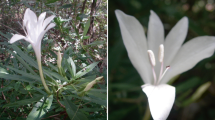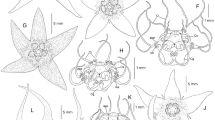Summary
As a precursor to the revision of the genus Canephora Juss., new and distinguishing generic characters are given, and a table of characters for the known species is included. Two new species from montane areas in northern Madagascar are described and illustrated: C. ambrensis S. E. Dawson, from Montagne d’Ambre and C. gyrobracteata S. E. Dawson from the Marojejy Massif.



Similar content being viewed by others
Notes
12 developing seeds observed in a locule of an obloid fruiting specimen of Canephora sp.
12 developing seeds observed in a locule of an obloid fruiting specimen of Canephora sp. Number of mature seeds not observed.
See Notes
See Notes
References
Bachman, S., Moat, J., Hill, A. W., de al Torre, J. & Scott, B. (2011). Supporting Red List threat assessments with GeoCAT: geospatial conservation assessment tool. In: V. Smith & L. Penev (eds), e-Infrastructures for data publishing in biodiversity science. Zookeys 150: 117 – 126. (Version BETA).
Beddome, R. H. (1874). The flora sylvatica for southern India [Forester’s Manual]: parts 27 – 28: 134/2, tab. 327. Gantz Brothers, Madras.
Bradford, J. C. & Miller, J. S. (2001). New taxa and nomenclatural notes on the flora of the Marojejy massif, Madagascar. V. Cunoniaceae: Weinmannia. Adansonia, sér. 3, 23: 219 – 236.
De Block, P. & Vrijdaghs, A. (2008). Ontogeny of inflorescences, flowers and fruits of Canephora madagascariensis (Octotropideae). In: H. Ochoterena, T. Terrazas, P. De Block & S. Dessein (eds), IV International Rubiaceae (Gentianales) Conference. Programme & Abstracts: 27. Scripta Bot. Belg. 44.
____ & ____ (2013). Development of reproductive organs in Canephora madagascariensis (Octotropideae – Rubiaceae). Pl. Ecol. Evol. 146: 310 – 327. http://dx.doi.org/10.5091/plecevo.2013.844
D’Cruze, N., Köhler, J. & Franzen, M. (2008). A conservation assessment of the amphibians and reptiles of the Foret d’Ambre Special Reserve, North Madagascar. Madagascar Conservation & Development 3: 44 – 54.
Du Puy, D. J. & Moat, J. F. (1996). A refined classification of the primary vegetation of Madagascar based on the underlying geology: using GIS to map its distribution and to assess its conservation status. In: W. R. Lourenço (ed.), Proceedings of the International Symposium on the 'Biogeography de Madagascar', Paris, pp. 205 – 218, + 3 maps. Editions de l’ORSTOM, Paris.
Gezon, L. L. & Freed, B. Z. (1999). Agroforestry and Conservation in Northern Madagascar: Hopes and Hinderances. African Studies Quarterly 3(2): 1 – 30.
Gmelin, J. F. (1791). Systema Naturae ed. 13 [bis]. Impensis Georg. Emanuel. Beer., Lipsiae.
Goodman, S. M. (2000). Description of the Parc National de Marojejy, Madagascar, and the 1996 Biological Inventory of the Reserve. In: S. M. Goodman (ed.), A Floral and Faunal Inventory of the Parc National de Marojejy, Madagascar: with reference to elevation variation. Fieldiana: Zoology, new series 97: 1 – 18.
Humbert, H. (1955). Une merveille de la nature à Madagascar. Première exploration botanique du massif du Marojejy et de ses satellites. Mém. Inst. Sci. Madagascar, Sér. B, Biol. Vég 6: 1 – 210.
IUCN (2012). IUCN Red List Categories and Criteria Version 3.1. Second edition. IUCN, Gland and Cambridge.
Jussieu, A. L. (1789). Genera plantarum secundum ordines naturales disposita. Viduam Herissant et Theophilum Barrois, Parisiis.
Miller, J. S. (1998). New taxa and nomenclatural notes on the flora of the Marojejy Massif, Madagascar. I. Capparaceae: A new species of Crateva. Novon 8: 167 – 169.
Moat, J. & Smith, P. (2007). Atlas of the vegetation of Madagascar, Royal Botanic Gardens, Kew.
Mouly, A., Kainulainen, K., Persson, C., Davis, A. P., Wong, K. M., Razafimandimbison, S. G. & Bremer, B. (2014). Phylogenetic structure and clade circumscriptions in the Gardenieae complex (Rubiaceae). Taxon 63: 801 – 818.
Perrier de la Bâthie, J. M. H. A. (1936). Commelinacées de Madagascar. In: H. Humbert (ed.), Notul. Syst. (Paris) 5 (3): 173 – 216.
____ (1937). Les Bulbophyllum de Madagascar. In: H. Humbert (ed.), Notul. Syst. (Paris) 6 (2): 41 – 124.
Raxworthy, C. J. & Nussbaum, R. A. (1994). A rainforest survey of amphibians, reptiles and small mammals at Montagne D’Ambre, Madagascar. Biol. Conserv. 69: 65 – 73.
Robbrecht, E. (1980). The Hypobathreae (Rubiaceae - Ixoroideae) 1. Delimitation and division of a new tribe. Bull. Jard. Bot. Natl. Belg. 50: 69 – 77.
____ (1988). Tropical woody Rubiaceae. Opera Bot. Belg. 1: 1 – 271.
____ , Bridson, D. M. & Debb, D. (1993). The south Indian genus Octotropis (Rubiaceae). An investigation of its characters and reinstatement of the tribal name Octotropideae. Opera Bot. Belg. 6: 81 – 91.
____ & Puff, C. (1986). A survey of the Gardenieae and related tribes (Rubiaceae). Bot. Jahrb. Syst. 108: 63 – 137.
Ruhsam, M. & Davis, A. P. (2007). A taxonomic revision of the genus Flagenium Baill. (Rubiaceae–Octotropideae). Bot. J. Linn. Soc. 155: 557 – 570.
Shorthouse, D. P. (2010). SimpleMappr, an online tool to produce publication-quality point maps. [Retrieved from http://www.simplemappr.net. Accessed 07 October, 2014].
Thiers, B. [continuously updated]. Index Herbariorum: A global directory of public herbaria and associated staff. New York Botanical Garden's Virtual Herbarium. http://sweetgum.nybg.org/ih/. Accessed October 2014.
Tosh, J., De Block, P., Davis, A. P., Dessein, S., Robbrecht, E. & Smets, E. F. (2008). The tribal placement of the monospecific tropical African genus Petitiocodon (Rubiaceae) based on molecular data and morphology. Blumea 53: 549 – 565.
United Nations Educational, Scientific and Cultural Organisantion (UNESCO) World Heritage Committee (2007). Decision 31 COM 8B.9. Nomination of natural, mixed and cultural properties to the world heritage list — Rainforests of the Atsinanana. Decisions adopted at the 31 st session of the world heritage committee (Christchurch).
____ (2010). Decision 34 COM 8C.1 Establishment of the World Heritage List in Danger (Inscribed Properties). Madagascar, Rainforests of Atsinanana. 34COM 7B.2. Report of the decisions adopted by the World Heritage Committee at its 34 th session (Brasilia).
Wernham, H. F. (1911). The Genus Canephora. J. Bot. 49: 77 – 82.
____ (1912). The Systematic Anatomy of the genus Canephora. Beih. Bot. Centralbl. 28 (1): 453 – 472.
Willis, F., Moat, J. & Paton, A. (2003). Defining a role for herbarium data in red list assessments: a case study of Plectranthus from eastern and southern tropical Africa. Biodivers. Conserv. 12: 1537 – 1552.
Acknowledgements
The author is grateful to the curators of BR, G, MO, P, TAN, TEF (abbreviations follow Thiers, [continuously updated]) for the loan of material.
Author information
Authors and Affiliations
Corresponding author
Rights and permissions
About this article
Cite this article
Dawson, S.E. Characteristics of the Madagascan genus Canephora (Rubiaceae: Octotropideae), and the description of two new species. Kew Bull 71, 45 (2016). https://doi.org/10.1007/s12225-016-9654-5
Accepted:
Published:
DOI: https://doi.org/10.1007/s12225-016-9654-5




